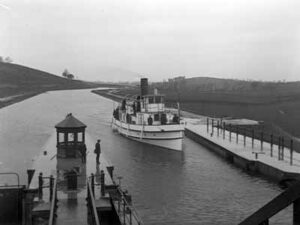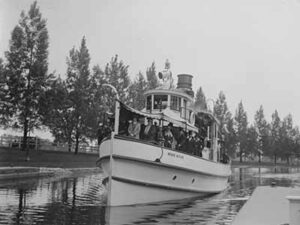The Waterway’s “JAGSHIP”
If you have attended Trent-Severn Waterway events you likely have seen the retired diesel tug TRENT. In season it sails up and down the Waterway acting as a marine “ambassador”. The TRENT is not the first working boat of the TSW, however; it was preceded by the somewhat notorious BESSIE BUTLER. 
The Polson Iron Works of Toronto built the steel hull for the BESSIE BUTLER, which was then covered with oak planking in Peterborough. She was 78 feet in keel, displaced 52.36 tons, and was listed as a steam tug. The tug was named for a daughter, Elizabeth (“Bessie”), of the then deputy-minister of Railways and Canals, Matthew Joseph Butler. The BESSIE spent her first season (1908) around Lakefield placing buoys, hauling supplies, towing vessels and scows, and tending to dredges.
Early in the BESSIE’s service, it was decided to build an oak-panelled cabin on her upper deck, complete with a galley and dining room, to suitably entertain dignitaries who might visit the waterway. She was equipped with logoed china and cutlery for dining, and berths for overnight trips. This cabin addition lessened the working capabilities of the vessel and to a degree changed the BESSIE BUTLER from a primarily working tug to a passenger cruiser for politicians, governors-general, senators, foreign visitors, and supporters of Wilfrid Laurier’s Liberal government. Opposition Conservatives dubbed her “the Jagship of the Trent” (“jag” was a common term for a drinking binge); when the Conservatives won the federal election in 1911, all Trent Canal staff – except the Superintendent – were fired for misusing the tug.
 The BESSIE BUTLER continued working and by 1950 was one of the last steamboats on the Waterway. During the Second World War, an additional task was to raise crashed military training aircraft from area lakes. In 1951, she was retired and replaced by the TRENT. The BESSIE BUTLER was sold and moved to Montreal, where she hauled explosives for a few years before being broken up – perhaps not an ideal demise for the former “Jagship of the Trent”, but she did prove herself to be a working steamboat right to the end.
The BESSIE BUTLER continued working and by 1950 was one of the last steamboats on the Waterway. During the Second World War, an additional task was to raise crashed military training aircraft from area lakes. In 1951, she was retired and replaced by the TRENT. The BESSIE BUTLER was sold and moved to Montreal, where she hauled explosives for a few years before being broken up – perhaps not an ideal demise for the former “Jagship of the Trent”, but she did prove herself to be a working steamboat right to the end.
By: Don Willcock,
The Peterborough Museum & Archives,
300 Hunter St E, Peterborough, 705-743-5180




